1966...and all that
memories of football and early days on cabin cruiser 'lady jena'
Like most people of my generation I remember England doing well in a certain football tournament. It was a big thing. I remember the winning goal which was heard loud and clear on a Ferguson transistor radio somewhere on the Thames. This was during our first holiday on a boat that belonged to the family.
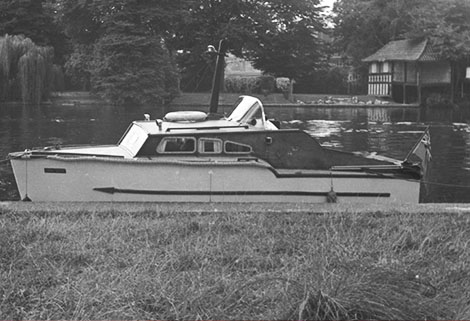 A modest windfall that spring meant we were able to buy a 16 foot, two berth “Rutland” cabin cruiser which the owner said was an Uffa Fox design. As a nine year old, I hadn’t a clue what that meant but I was sure it was a good thing.
A modest windfall that spring meant we were able to buy a 16 foot, two berth “Rutland” cabin cruiser which the owner said was an Uffa Fox design. As a nine year old, I hadn’t a clue what that meant but I was sure it was a good thing.
The boat was powered by a 10 horsepower Albin petrol engine, had a few creature comforts and bore the name “Lady Jena.”
All seemed well apart from the fact that there were four of us. This meant we needed 2 extra bunks and some more storage space so out went the water tank and sink. Given the tank was corroded and the sink scratched and cracked, it didn’t really matter. Out too went the petrol stove which my mum decided was dangerous, to be replaced by a succession of methylated spirit stoves, some of which definitely were!
With a bit of fiddling about, we were good to go on holiday up and down the Thames again. That’s when we discovered that the motor wasn’t too reliable, often stopping in midstream or refusing to start when we had to exit from a lock.
 It was our boat and we were on holiday in her so, to me, she was the best craft on the whole river despite the discovery of a couple of soft spots in the plywood hull. On a good day, the motor had a good solid twin cylinder thump that sounded as though it could run forever and we plodded the familiar route to Lechlade and back, pausing to hear the famous words “They think it’s all over… It is now,” whilst waiting to go into Penton Hook lock.
It was our boat and we were on holiday in her so, to me, she was the best craft on the whole river despite the discovery of a couple of soft spots in the plywood hull. On a good day, the motor had a good solid twin cylinder thump that sounded as though it could run forever and we plodded the familiar route to Lechlade and back, pausing to hear the famous words “They think it’s all over… It is now,” whilst waiting to go into Penton Hook lock.
The next year, mum and dad decided to explore the canals (beginning my lifelong love affair with the things).
With a few more modifications, which included an escape hatch, removal of the mast, a transom bunk, a new and even more dangerous methylated spirit stove and an upgraded toilet (which was truly evil) we set off. Our trip took us to Napton and back, with a quick trip to Lechlade thrown in.
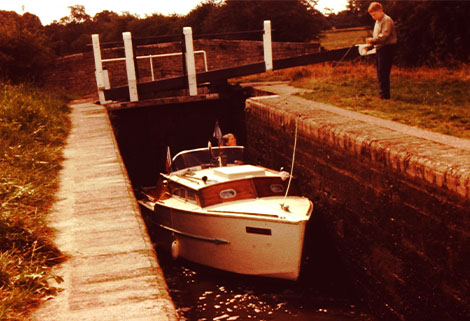 The next year, we got a bit beyond Braunston, becoming a bit more adventurous with each passing holiday.
The next year, we got a bit beyond Braunston, becoming a bit more adventurous with each passing holiday.
Modifications to the boat were planned and executed during the year, the most major of these being the covered cockpit. This changed the appearance of the craft and, to my eyes, made it look a bit ungainly. It did at least provide a space that didn’t leak when it rained. The old pram cover was little better than being out in the open, and we never did get far with stopping the cabin top leaking. This wasn’t helped at all when a gust of wind somewhere near Somerton deep lock caught the back of the boat causing the cover to be ripped on the arch of a bridge during a thunderstorm. We carried on undaunted whilst Mum sewed the thing back together with an embroidery needle and white cotton as the storm continued unabated.
When my brother and I were old enough, we were given the privilege of operating the locks, this also being the first year we had a go at the Hatton flight. I found the mechanisms rather odd after the rack and pinions of the Oxford canal and, whilst easy to work, the things gave me a good few blisters from the rough cast BWB standard windlass that I was using.
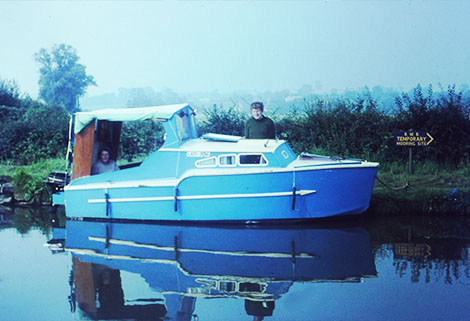 This, I think, was also the year that our holiday nearly came to an abrupt halt at Henley on Thames when a small hourly hired aluminium motorboat put a hole in our side. We heard someone shout “Slow down.” They sped up and the sickening thud followed. We had a hole you could nearly put your head through just a few inches above the waterline, and the occupants of the motor boat had done the proverbial runner. The yard helped us out with some plywood to patch the hole and we were on our way within a surprisingly short time. I’m not sure what was paid by who or to whom but we still had a decent holiday out of it.
This, I think, was also the year that our holiday nearly came to an abrupt halt at Henley on Thames when a small hourly hired aluminium motorboat put a hole in our side. We heard someone shout “Slow down.” They sped up and the sickening thud followed. We had a hole you could nearly put your head through just a few inches above the waterline, and the occupants of the motor boat had done the proverbial runner. The yard helped us out with some plywood to patch the hole and we were on our way within a surprisingly short time. I’m not sure what was paid by who or to whom but we still had a decent holiday out of it.
I remember one year where the engine didn’t break down, the sun shined (no problem with leaks) and just about everything went well. I also remember that during the following winter, Lady Jena sank. She rose from the watery ashes to return to the river with a new sheet of plywood replacing the one with the soft spots, and new blue paintwork. Also, because of the need for space, and water damage to the motor, it was decided to power her with an outboard. The first of these, an “Ocean four plus,” lasted us from Kingston upon Thames to Kiddlington in Oxfordshire whereupon it seized up solid and was returned under warranty. The replacement, a 1967 Mercury 3.9 was an absolute gem and powered Lady Jena until another young family bought her from us in 1972.
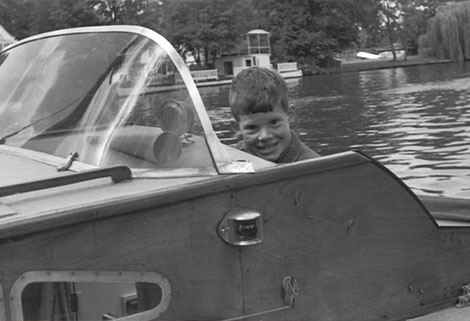 Overall, my memories of our first boat are very happy ones. I could forget about school and let myself be fascinated by my surroundings even when I had to keep a diary one summer for a school project which was forgotten about the following September.
Overall, my memories of our first boat are very happy ones. I could forget about school and let myself be fascinated by my surroundings even when I had to keep a diary one summer for a school project which was forgotten about the following September.
The diary became the backdrop to my first book “Mayfly” and the little Rutland cabin cruiser appears in my third book “Emily’s Journey” as “Willow Wisp III.” In the book I decided to give her a rather more reliable motor though.
For all these reasons, I remember 1966 as the year Lady Jena changed my life.
There was something about some football match too I think.

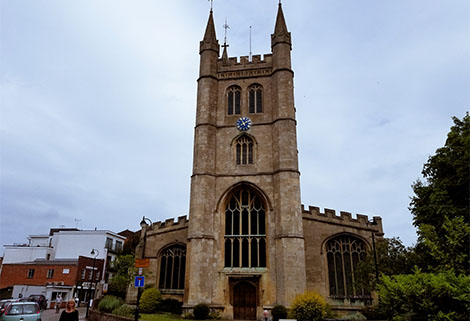

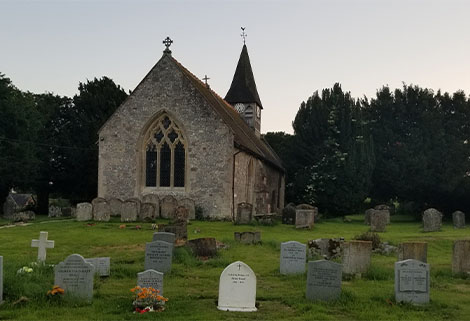

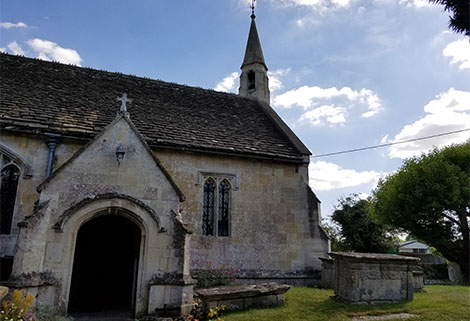

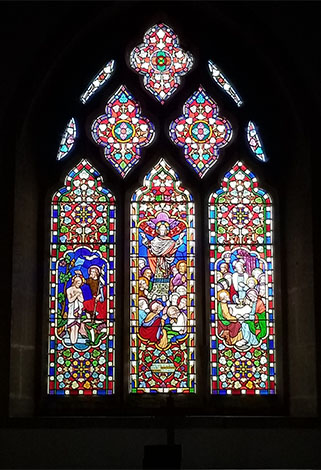
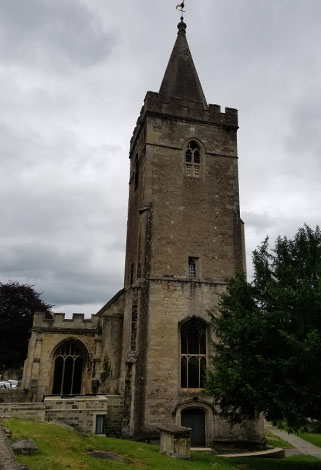
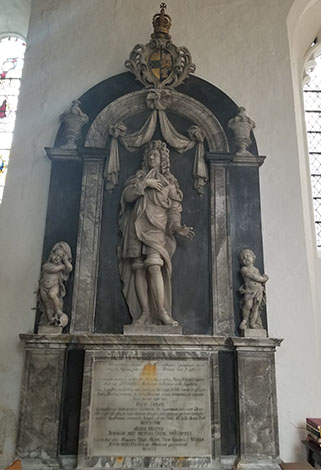

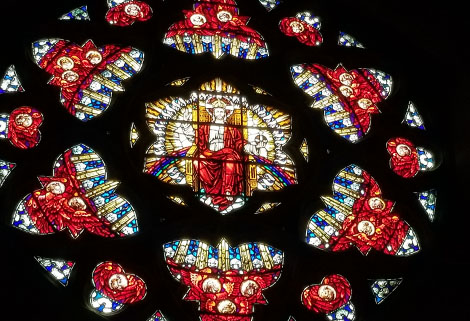

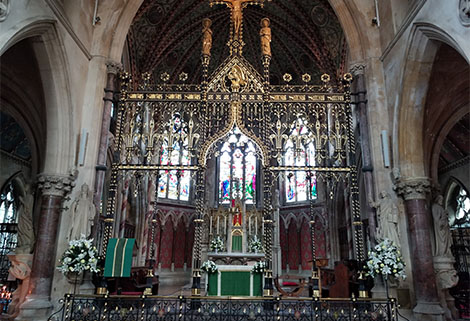

 I wasn't able to enter this lovely old church. I'm told it's beautiful inside, with large stained glass windows and a carved quire screen. It was started in the 13th century and has an extensive cemetery surrounding it.
I wasn't able to enter this lovely old church. I'm told it's beautiful inside, with large stained glass windows and a carved quire screen. It was started in the 13th century and has an extensive cemetery surrounding it.
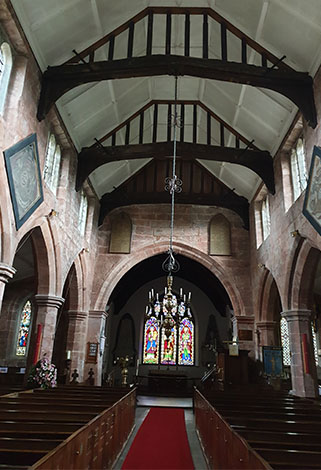


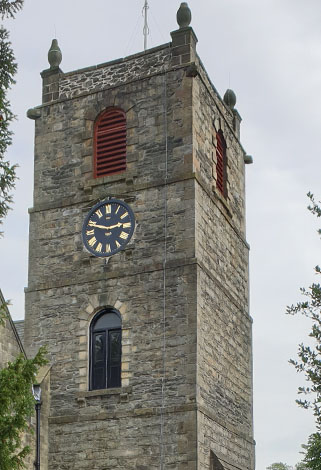
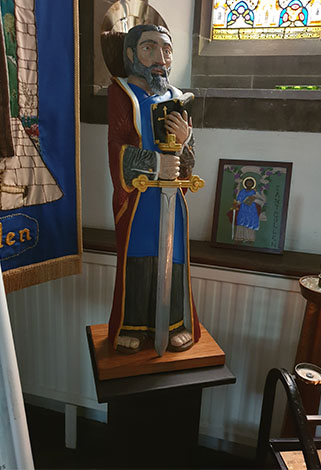
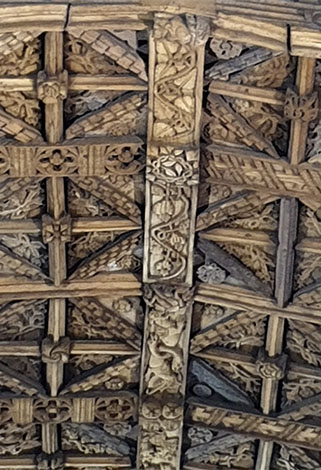
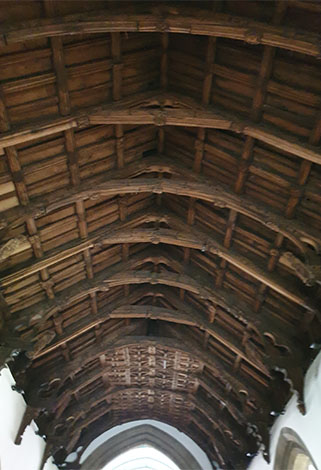
 Llangollen is said to have taken its name from St. Collen, a 6th century monk that founded a church here, beside the River Dee where he arrived by coracle.
Llangollen is said to have taken its name from St. Collen, a 6th century monk that founded a church here, beside the River Dee where he arrived by coracle. Weather conditions play an important part when painting outside. Avoid if possible painting in direct sunlight or when the boat is obviously warm to the touch. The ideal temperature for painting is between 12oC and 20oC. Higher temperatures could result in poor flow, rapid drying and loss of gloss. Windy conditions will lead to dirt pick-up and faster drying. Do not apply in damp conditions and aim at finishing painting by mid-afternoon, as overnight condensation may affect the finish.
Weather conditions play an important part when painting outside. Avoid if possible painting in direct sunlight or when the boat is obviously warm to the touch. The ideal temperature for painting is between 12oC and 20oC. Higher temperatures could result in poor flow, rapid drying and loss of gloss. Windy conditions will lead to dirt pick-up and faster drying. Do not apply in damp conditions and aim at finishing painting by mid-afternoon, as overnight condensation may affect the finish.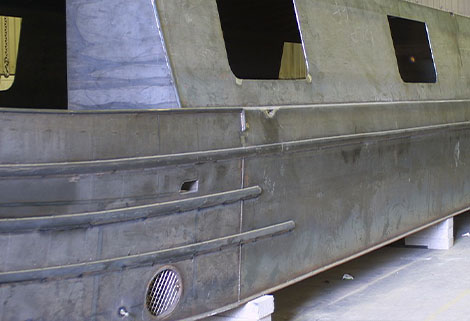 BARE STEEL
BARE STEEL  PREVIOUSLY PAINTED SURFACES
PREVIOUSLY PAINTED SURFACES 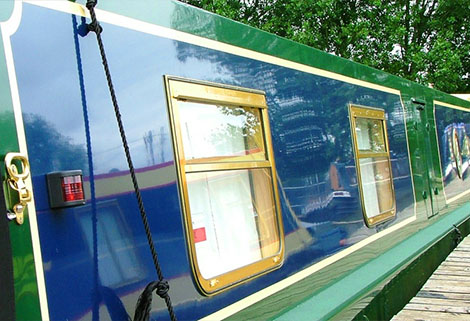 Apply the paint using a good quality 2½” to 3” brush. Gloss rollers and pads can also be used. To ensure even application, apply by crossing brush strokes before laying-off. On boat sides, always lay-off with vertical strokes. With large areas such as cabin tops, best results can be obtained by two people applying to prevent loss of wet edge – one person applying, the other laying-off. When brushing, it is recommended that the brush is held at 45 degrees to minimise brush marking. Where masking tape is being used, it is recommended that this is removed before the paint has reached a light touch-dry state, as this will ensure a smoother edge.
Apply the paint using a good quality 2½” to 3” brush. Gloss rollers and pads can also be used. To ensure even application, apply by crossing brush strokes before laying-off. On boat sides, always lay-off with vertical strokes. With large areas such as cabin tops, best results can be obtained by two people applying to prevent loss of wet edge – one person applying, the other laying-off. When brushing, it is recommended that the brush is held at 45 degrees to minimise brush marking. Where masking tape is being used, it is recommended that this is removed before the paint has reached a light touch-dry state, as this will ensure a smoother edge.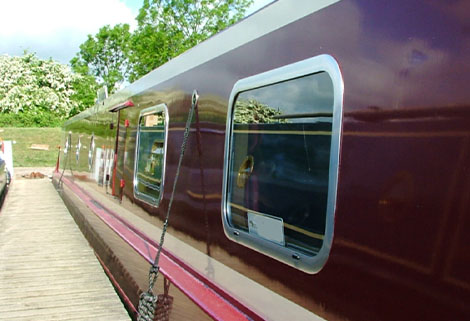 Wipe over thoroughly after abrading, as dust and debris will affect the final appearance. The smoothness of the finish is ultimately dependent on the preparation, especially for Undercoats and Primer/Filler. Where coarse profile steel has been used, or where underlying imperfections in the surface exist, extra coats of Primer/Filler and Undercoats should be used.
Wipe over thoroughly after abrading, as dust and debris will affect the final appearance. The smoothness of the finish is ultimately dependent on the preparation, especially for Undercoats and Primer/Filler. Where coarse profile steel has been used, or where underlying imperfections in the surface exist, extra coats of Primer/Filler and Undercoats should be used. NEW WOOD
NEW WOOD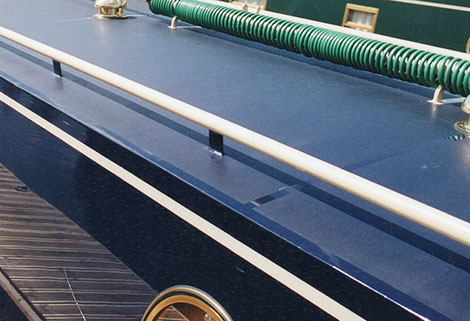 Rylard Slip Resistant additive can be used with all Rylard topcoats.
Rylard Slip Resistant additive can be used with all Rylard topcoats.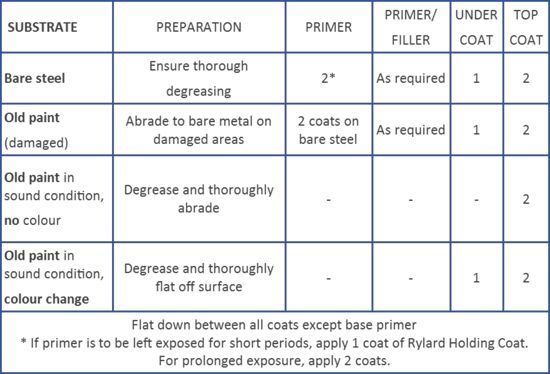
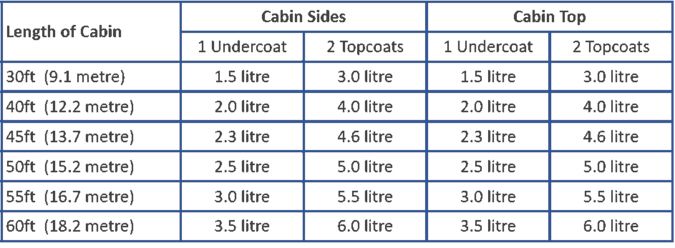
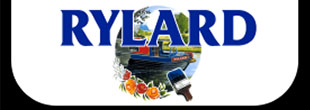 Rylard Paints is a well-respected name in the supply of paints for canal boats, narrow boats, dutch barges and leisure craft. Through its Research and Development program Rylard continues to provide state-of-the-art products, manufactured in the UK to the highest Quality standards. We provide a range of coatings for canal boats, from blacking to topsides, anti-slip for decks and roofs, to brass lacquer to keep metal fitments glowing.
Rylard Paints is a well-respected name in the supply of paints for canal boats, narrow boats, dutch barges and leisure craft. Through its Research and Development program Rylard continues to provide state-of-the-art products, manufactured in the UK to the highest Quality standards. We provide a range of coatings for canal boats, from blacking to topsides, anti-slip for decks and roofs, to brass lacquer to keep metal fitments glowing.
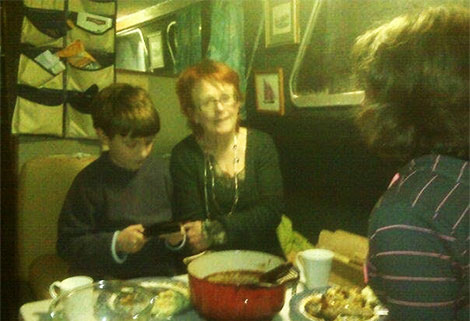
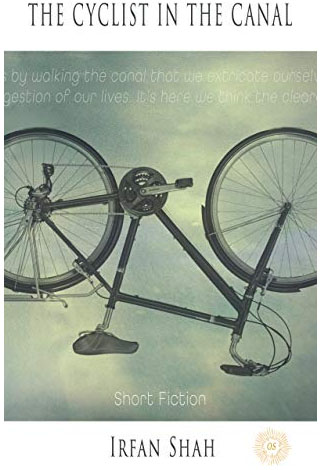 “In Rodley, the barges huddle, moored tight against the towpath alongside small wooden huts and deck chairs and sleeping pets.”
“In Rodley, the barges huddle, moored tight against the towpath alongside small wooden huts and deck chairs and sleeping pets.” 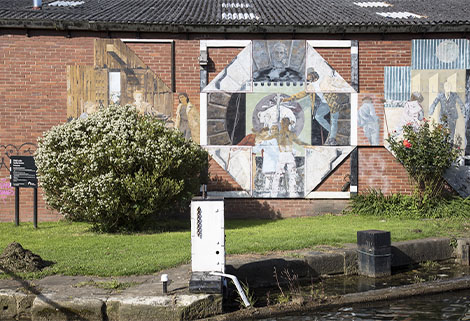
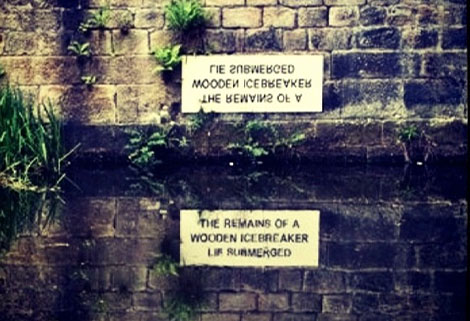
 I’d become used to writing non-fiction before I wrote ‘Cyclist’.
I’d become used to writing non-fiction before I wrote ‘Cyclist’.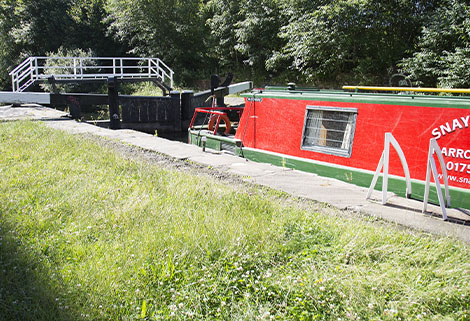 The canal-side is a shared space that is open, equally, to everyone. It serves as an escape to the country for city dwellers and after these strange days of lock-down, I hope that people will return to it with a renewed love and appreciation for what it offers us.
The canal-side is a shared space that is open, equally, to everyone. It serves as an escape to the country for city dwellers and after these strange days of lock-down, I hope that people will return to it with a renewed love and appreciation for what it offers us.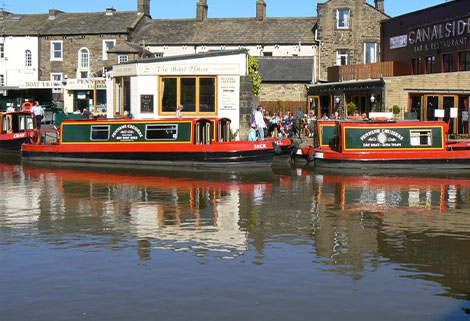 Through odd canal holidays, trips on the rivers and being fortunate enough to have friends on the canals as a child, I eventually caught up with our fantastic inland waterways and the lovely people that live, work and holiday on them. We found a fantastic company to hire from, Pennine Cruisers. A Skipton based company on that lovely Leeds and Liverpool canal. This company soon became the key to the start of Yorkshire Bespoke Tiller Pins. As the article goes on you will see why. All staff and owners, over many trips with them, soon became what me and my wife class as our Skipton family.
Through odd canal holidays, trips on the rivers and being fortunate enough to have friends on the canals as a child, I eventually caught up with our fantastic inland waterways and the lovely people that live, work and holiday on them. We found a fantastic company to hire from, Pennine Cruisers. A Skipton based company on that lovely Leeds and Liverpool canal. This company soon became the key to the start of Yorkshire Bespoke Tiller Pins. As the article goes on you will see why. All staff and owners, over many trips with them, soon became what me and my wife class as our Skipton family. On rummaging around, I found an old piece of round brass stock, along with a solid piece of aluminium from my workshop stock. Straight away I knew I was going to make him a tiller pin. The two pieces of material had caught my eye, even though they were both very dull. I thought that if I could use the two pieces together, the result would be quite unique. I began looking at new ways on how to work and join the two pieces together. I also knew when they were machined, they had to give a flawless impression as though they were all from one piece. I eventually found a way to do this and set about making the blank into an attractive eye-catching shape. This just seemed to flow and sooner rather than later, the tiller pin was made. I was unsure if I was on the right track with it all, so for a bit of confirmation I sent a picture of it to ‘Our Zoe’ at Pennine Cruisers to ask her opinion. I was expecting some changes may be needed, but all I got from Zoe was ‘Wayne is going to love that!’ It was buffed, polished and ready for our trip up to Skipton for our next of now many boat trips.
On rummaging around, I found an old piece of round brass stock, along with a solid piece of aluminium from my workshop stock. Straight away I knew I was going to make him a tiller pin. The two pieces of material had caught my eye, even though they were both very dull. I thought that if I could use the two pieces together, the result would be quite unique. I began looking at new ways on how to work and join the two pieces together. I also knew when they were machined, they had to give a flawless impression as though they were all from one piece. I eventually found a way to do this and set about making the blank into an attractive eye-catching shape. This just seemed to flow and sooner rather than later, the tiller pin was made. I was unsure if I was on the right track with it all, so for a bit of confirmation I sent a picture of it to ‘Our Zoe’ at Pennine Cruisers to ask her opinion. I was expecting some changes may be needed, but all I got from Zoe was ‘Wayne is going to love that!’ It was buffed, polished and ready for our trip up to Skipton for our next of now many boat trips.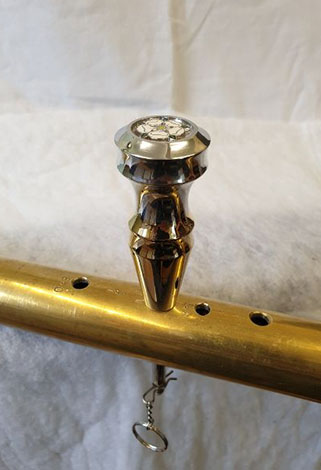 By our next visit 6 weeks later, now October 2019, I had come up with 4 new designs all combining brass and aluminium. However, one of these was clearly turning heads: Tiller Pin Zoe (all my pins are named after the staff at Pennine Cruisers). Tiller pin Zoe was a little different, because I had incorporated a recess in the top to house an enamel Yorkshire rose.
By our next visit 6 weeks later, now October 2019, I had come up with 4 new designs all combining brass and aluminium. However, one of these was clearly turning heads: Tiller Pin Zoe (all my pins are named after the staff at Pennine Cruisers). Tiller pin Zoe was a little different, because I had incorporated a recess in the top to house an enamel Yorkshire rose.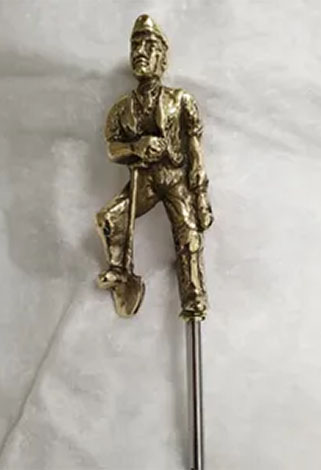 I started getting odd jobs - repairs, lathe work brazing and odd bits. Then people started sending me brass items that they wanted me to turn into tiller pins. Many were hollow and could not accommodate a good thread for the actual pin itself. So, I would machine a solid brass boss, then tig braze that to the hollow cast body. This was becoming a popular request, and other work started to flow in. Praise for my work was building and it was common for customers to say they were told that what I managed to do couldn’t be done. I suppose wrong advise from wrong person scenario.
I started getting odd jobs - repairs, lathe work brazing and odd bits. Then people started sending me brass items that they wanted me to turn into tiller pins. Many were hollow and could not accommodate a good thread for the actual pin itself. So, I would machine a solid brass boss, then tig braze that to the hollow cast body. This was becoming a popular request, and other work started to flow in. Praise for my work was building and it was common for customers to say they were told that what I managed to do couldn’t be done. I suppose wrong advise from wrong person scenario. The rate and pace to me was exhausting. Sammie was relentless. Left no stone unturned. Within three days Yorkshire bespoke tiller pins had a running Facebook account. Had a web site not only built, but up and running. Had a PayPal account set up etc. Groups were getting in touch from our posts asking us to join. I had picked up my first big order thanks to Finesse boats who were very helpful and encouraging. This led to me finding a Sheffield based enamel logo and badge place. Which led to a local material suppliers Avus Metals. The snowball effect was starting to happen. New customers from the website and from Facebook were steadily on the up. Comments and positive feedback were a massive incentive for me to carry on. What really hit home was just how willing the much bigger companies, boat builders, marinas online canal merchants were to get behind the little firms. It really felt like big brothers were keeping a look out.
The rate and pace to me was exhausting. Sammie was relentless. Left no stone unturned. Within three days Yorkshire bespoke tiller pins had a running Facebook account. Had a web site not only built, but up and running. Had a PayPal account set up etc. Groups were getting in touch from our posts asking us to join. I had picked up my first big order thanks to Finesse boats who were very helpful and encouraging. This led to me finding a Sheffield based enamel logo and badge place. Which led to a local material suppliers Avus Metals. The snowball effect was starting to happen. New customers from the website and from Facebook were steadily on the up. Comments and positive feedback were a massive incentive for me to carry on. What really hit home was just how willing the much bigger companies, boat builders, marinas online canal merchants were to get behind the little firms. It really felt like big brothers were keeping a look out.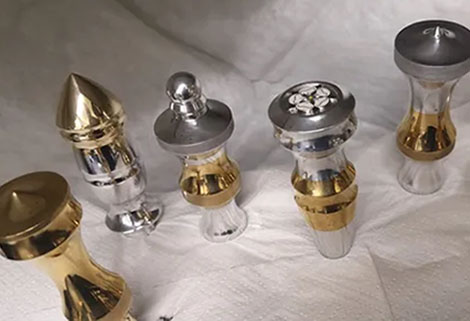 It is very early days. I have a range of tiller pin bodies now and there will be more designs in the future. All named after Pennine Cruisers staff. There are now many other material options available and body material combinations. I am passionate about brass ware and love to repair figures that are broken – it gives them a second chance with a fantastic view from the tiller for their retirement. I find it very warming to know I have turned a personal object into a lovely tiller pin for someone. I now incorporate and work with more enamel options in my own tiller pin range along with boat name plates. I’m also venturing into other things for my growing customers, the cards are still on the table, but I believe they will be something to consider on your boat.
It is very early days. I have a range of tiller pin bodies now and there will be more designs in the future. All named after Pennine Cruisers staff. There are now many other material options available and body material combinations. I am passionate about brass ware and love to repair figures that are broken – it gives them a second chance with a fantastic view from the tiller for their retirement. I find it very warming to know I have turned a personal object into a lovely tiller pin for someone. I now incorporate and work with more enamel options in my own tiller pin range along with boat name plates. I’m also venturing into other things for my growing customers, the cards are still on the table, but I believe they will be something to consider on your boat.
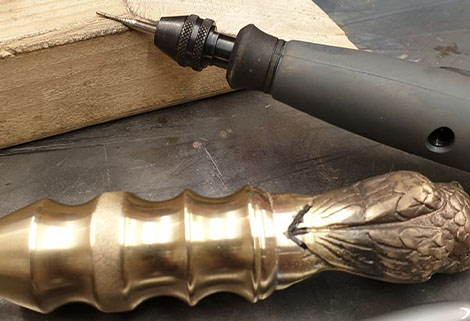

 Boatmen 100 years ago would have related to this very well. They were no strangers to competing against each other for the swankiest turn out as a distraction from the grinding pressure to get 'em ahead. Long before the advent of the show, christenings, weddings, even funerals would see the boat drawn by an a horse in full turn out, and May Day for one had been traditionally a day when “more brass than 'oss” would be presented to the world regardless of where you were. Indeed it could be profitable exercise even if there was no show to attend, as one man at Cannock Chase had a hobby of giving 10 bob to the horse he felt was the best turned out that day.
Boatmen 100 years ago would have related to this very well. They were no strangers to competing against each other for the swankiest turn out as a distraction from the grinding pressure to get 'em ahead. Long before the advent of the show, christenings, weddings, even funerals would see the boat drawn by an a horse in full turn out, and May Day for one had been traditionally a day when “more brass than 'oss” would be presented to the world regardless of where you were. Indeed it could be profitable exercise even if there was no show to attend, as one man at Cannock Chase had a hobby of giving 10 bob to the horse he felt was the best turned out that day.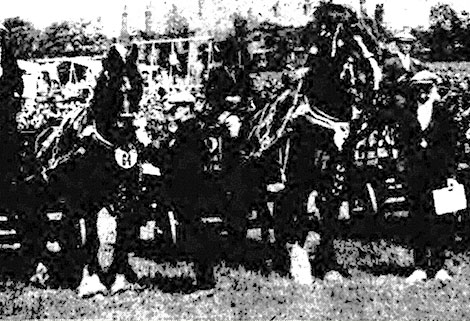 As with the heavy horse shows today, judging for turnouts involves a parade of the participants; but unlike today where they're confined to a show ring, the West Bromwich horses took a turn around the entire borough.
As with the heavy horse shows today, judging for turnouts involves a parade of the participants; but unlike today where they're confined to a show ring, the West Bromwich horses took a turn around the entire borough.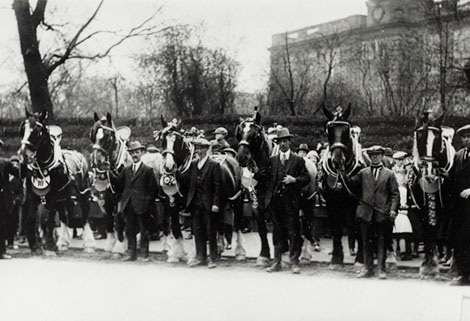 It's affecting to look at the newspaper reports and see the names of horses long past; in 1927 for example, Fellows Morton & Clayton's “Duke” won 3rd prize in the Heavy Cart Mare or Gelding (radius 7 miles from Smethick boundry), while Cooper & Co took first place in Cleanest & Smartest Canal Boat Horse with “Snowball”, Leonard Leigh's horses “Prince” and “Toby” taking 2nd and 3rd respectively, Hingley & Son's “Blossom” taking 4th and Midlands and Coast's “Jack” taking 5th.
It's affecting to look at the newspaper reports and see the names of horses long past; in 1927 for example, Fellows Morton & Clayton's “Duke” won 3rd prize in the Heavy Cart Mare or Gelding (radius 7 miles from Smethick boundry), while Cooper & Co took first place in Cleanest & Smartest Canal Boat Horse with “Snowball”, Leonard Leigh's horses “Prince” and “Toby” taking 2nd and 3rd respectively, Hingley & Son's “Blossom” taking 4th and Midlands and Coast's “Jack” taking 5th.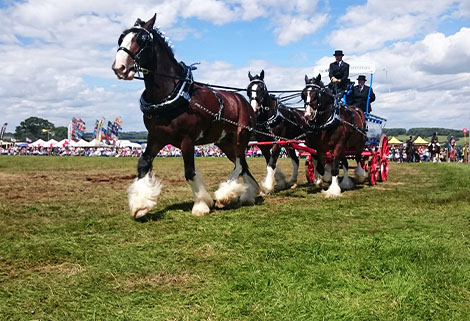 Disagreements with the judges happened then as now. Cooper & Co (who cleaned the table in the 1927 show) entered “Roger” in the 1925 Cleanest & Smartest Canal Boat Horse class, and after he'd successfully gained 2nd place from the judge, he had a fit, collapsed and had to shot. To add insult to injury, they then gave the second place to another horse on the grounds of breathing being a vital part of the turnout. This shouldn't have caused as much friction as it did at the time, Cooper's having already secured first place with a different horse anyway.
Disagreements with the judges happened then as now. Cooper & Co (who cleaned the table in the 1927 show) entered “Roger” in the 1925 Cleanest & Smartest Canal Boat Horse class, and after he'd successfully gained 2nd place from the judge, he had a fit, collapsed and had to shot. To add insult to injury, they then gave the second place to another horse on the grounds of breathing being a vital part of the turnout. This shouldn't have caused as much friction as it did at the time, Cooper's having already secured first place with a different horse anyway.


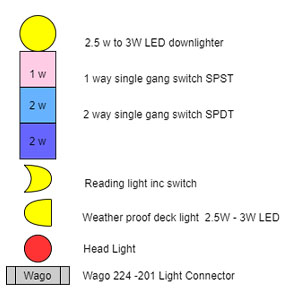 So lets get started; the first thing I do is a symbol chart for everything that is going to be on the drawing, switches of the various types, the different types of lights etc. No complex electrical symbols that you do not know or understand just simple symbols. A Symbols list is to remind you what they are and what they do. Do not worry if you cannot think of everything you need or you miss some. They can easily be added to the Symbols list as you go on. But do it and do not rely on your memory. When you have to find faults the drawing becomes the map of what is there. Also when you come to sell the sell the boat the new owners will be impressed that there is a set of electrical drawings. It could get that sale, where it was only 50/50 in the buyers mind before. It shows that care has been taken of the boat from day one. How often do you hear boaters grumbling that all they have a jumble of cables and no drawings to tell them what should do what, please make sure you do Electrical Drawings for your boat, it is not difficult and will make installing them easier as well as fault finding is easier for whoever follows you.
So lets get started; the first thing I do is a symbol chart for everything that is going to be on the drawing, switches of the various types, the different types of lights etc. No complex electrical symbols that you do not know or understand just simple symbols. A Symbols list is to remind you what they are and what they do. Do not worry if you cannot think of everything you need or you miss some. They can easily be added to the Symbols list as you go on. But do it and do not rely on your memory. When you have to find faults the drawing becomes the map of what is there. Also when you come to sell the sell the boat the new owners will be impressed that there is a set of electrical drawings. It could get that sale, where it was only 50/50 in the buyers mind before. It shows that care has been taken of the boat from day one. How often do you hear boaters grumbling that all they have a jumble of cables and no drawings to tell them what should do what, please make sure you do Electrical Drawings for your boat, it is not difficult and will make installing them easier as well as fault finding is easier for whoever follows you.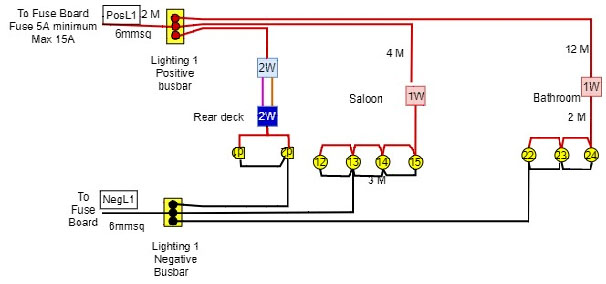
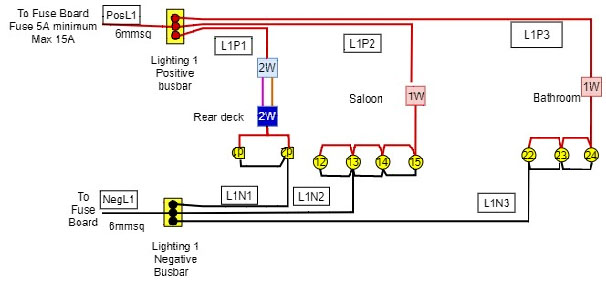

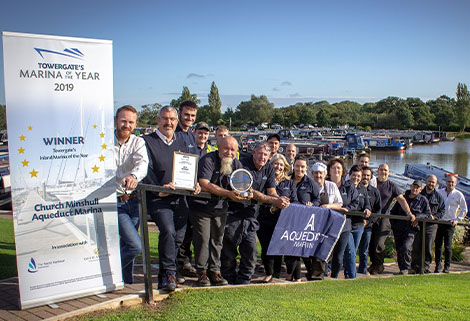
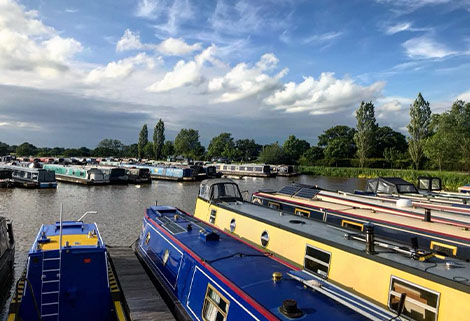 Staff who are placed onto the governments furlough scheme have to be furloughed for a minimum of three weeks and we always planned to use this time to take stock and risk assess our operation in order to get staff back to work as soon as safely possible, which is what we are now doing.
Staff who are placed onto the governments furlough scheme have to be furloughed for a minimum of three weeks and we always planned to use this time to take stock and risk assess our operation in order to get staff back to work as soon as safely possible, which is what we are now doing.  We are extremely fortunate to have a fantastic team at the marina and all the staff have been very understanding during these times. The engineers are indeed pleased to be back at work and back to some form of normality during these uncertain times. As a leisure business we have qualified for a full rates relief, Cheshire East were very quick to implement our application. The furlough scheme was easy to apply for and paid out promptly, the bank was responsive to our request to put the loan repayments to interest only for three months.
We are extremely fortunate to have a fantastic team at the marina and all the staff have been very understanding during these times. The engineers are indeed pleased to be back at work and back to some form of normality during these uncertain times. As a leisure business we have qualified for a full rates relief, Cheshire East were very quick to implement our application. The furlough scheme was easy to apply for and paid out promptly, the bank was responsive to our request to put the loan repayments to interest only for three months. 